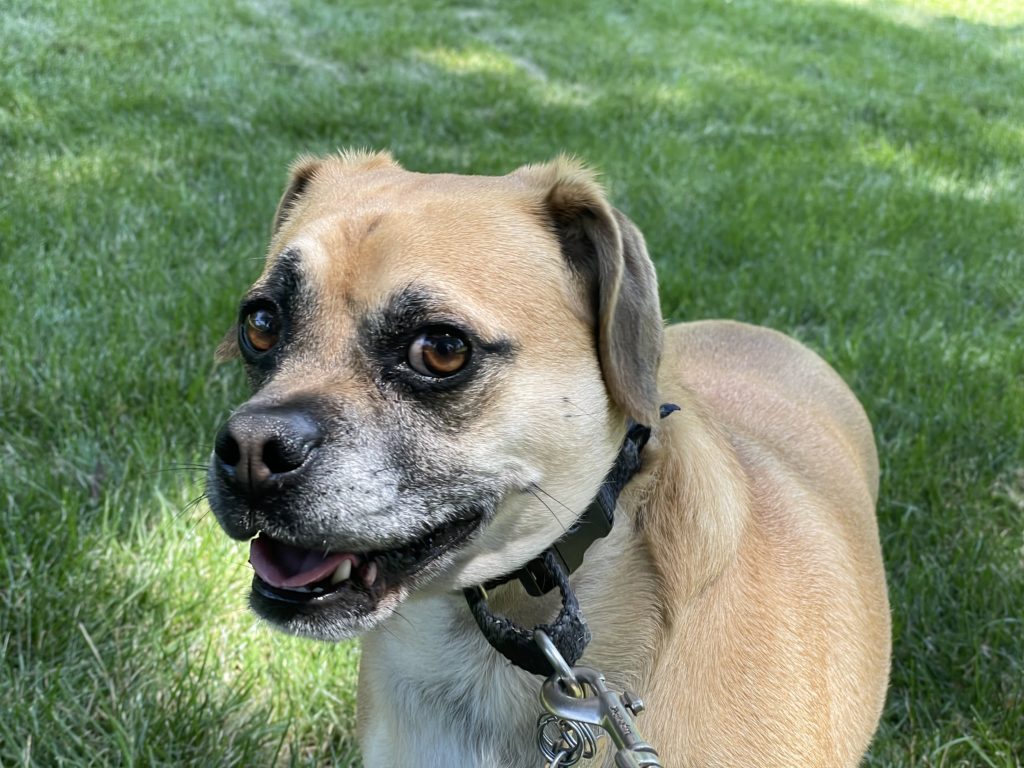Tips on How to Stop Dogs From Being Scared of Strangers
By: David Codr
Published Date: July 18, 2022
For this Omaha in home dog behavior session we work with Dylan the Puggle; sharing tips on how to stop dogs from being scared of strangers.
Dylan is a rescue dog who had a pretty intense case of separation anxiety and also likes to bark at people he doesn’t know. Many scared or insecure dogs bark to get people to move away and for good reason; it works.
Operant conditioning is one of the ways the dogs learn and essentially the principal is the dog does something and then something happens afterwards as a result of the dog’s actions. So if you have a dog that barks at strangers because it wants them to leave, and eventually the stranger leaves, that reinforces the barking behavior.
I met Dylan outside to try to mitigate his barking and use a few Dog Behaviorist tricks with marginal success. He was still a very anxious dog but after a few minutes had settled down a bit, so I took the leash from his guardian and took him out for a short sniff walk. Sniffing is a normal behavior for dogs and can help them relax and calm them down. We were successful in getting him to stop barking until we encountered another stranger and at that point Dylan went back to his old barking ways.
How to stop dogs from being scared of strangers
.
When we returned to his home Dylan was still anxious and so I spent a good portion of time talking about how his guardian can make some small changes to help him feel less anxious and fearful around strangers as well as how to create a healthy leader follower dynamic.
Because Dylan is a little push and demanding at times, I suggested she started using the Premack principle which means a less desirable behavior earns a more desirable behavior. Asking Dillon to sit before getting up on the couch or a lay down before petting when he demands attention or a sit / touch his nose to her hand prior to meal time can help him get into a habit of asking his guardian versus telling.
Since he didnt know how, I wanted to show the guardian how to teach Dylan a hand targeting exercise. I like using hand targeting because it’s a great way to gauge whether or not a dog wants to engage with someone or not (its primary purpose is to help you move or reposition a dog without pushing them).
Now its importnat to note that you should not do hand targeting with a dog that you think may bite you or is not comfortable with you. But since Dylan had warmed up to me slightly throughout the session, I thought this might be a good opportunity to give him a tool to communicate whether or not he feels comfortable with a stranger or not.
If you want to learn how to teach your dog how to do the hand targeting exercise, check out the free positive dog training video below.
The guardian struggled at first, but after she started chopping her hand in a more deliberate motion and using the marker word more precicisely when he touched his nose to her hand, Dylan started to get it. I recommended the guardian and husband practice this with Dylan a couple of times a day and short one or two minute practice sessions so that Dylan is comfortable with the exercise. I also advised them to not have strangers do this cue unless they were pretty sure Dylan was comfortable with them. Stopping dogs from being scared of strangers is a process.
I also recommended the guardian practice our celebrating technique. This involves using the marker word and rewarding the dog whenever it does desirable behaviors on its own. Earlier in the session, the guardian had mentioned that Dylan struggled to lay down on cue. This is a great way to motivate dogs to do that action. Every time Dylan lays down on hos own, his guardian should say “good boy” (their marker word) and then follow up with a treat or a pet. Overm time, Dylan should start to lay down easier and then guardians can teach him how to lay down on cue.
By the end of the session, Dylan was pooped. His gardian and I spent a few minutes discussing a couple loose ends, some marching orders and our next in-home Omaha dog training session where we will work on a version of behavior adjustment training.
Categorized in: Dog Behavior


